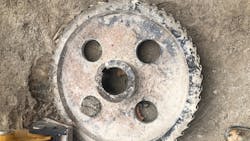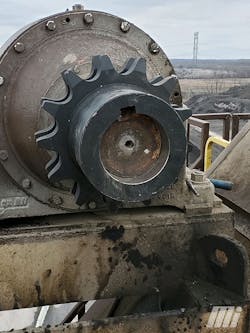Reliability produces profitable results
Capital projects are common in many industrial facilities across the United States. There was a recent report that named four specific industries — mining, metal, pulp and paper — which collectively are spending $33.19 billion in capital expenditures in 2020 alone. To ensure that your company will get a good return on your investments — and turn that into profit dollars due to uninterrupted production — it is important to follow a proven process.
Initial correspondence and end-user expectations
Whether it is a newly designed conveyor system or a redesigned system, there needs to be an initial line of communication between either the manufacturer or distributor, and the end user. Laying out the expectations of the end user will allow the manufacturer to design the system according to the end user’s specific tonnage requirements and, in some cases, budgetary restrictions. In the cases of a redesigned system, it allows the manufacturer to refer to the original operating context, obtain current production information and evaluate maintenance processes. Equipment rental requirements and PPE should be discussed during this initial meeting, along with any additional on-site or pre-job safety training other than the federal- or state-mandated safety requirements.
Furthermore, it may be a good idea to have a good cross section of all stakeholders in the facility — senior-level managers, front-line supervisors, engineering, electrical, production, maintenance and reliability engineers — involved in this initial meeting to discuss capabilities and/or restrictions. This will ensure that these departments have a clear understanding of the requirements and know their part in making the design, fabrication, installation and operation a success with a measurable outcome.
Assess and evaluate current conditions
Sometimes the ground is too soft, and the structure’s design must be evaluated and/or the landscaping needs to be fortified. Sometimes excessive exposure to natural elements will affect the reliability of the components. In some cases, the original design was not engineered properly and needs to be re-evaluated. In some aggregate applications, there could be severe conditions that are not otherwise communicated in initial meetings and conversations — conditions that can drastically affect the component reliability. A plant visit is crucial to assess and evaluate all the conditions before designing a new conveyor system or redesigning a current application.
Here’s an actual scenario: A mining customer of ours was utilizing a chain-driven conveyor with custom, made-to-order sprockets, exposing the chain and components to the open elements. Replacement sprockets had an excessive lead time, and keeping these properly lubricated and free of debris was becoming an issue. We were able to reverse engineer the system and come up with a more readily available shaft-mount reducer option. Adding reducer housing to protect the gearing components, as well as belt guards to protect the drive system, extended drive system life significantly, not to mention that replacement parts are easier to access.
Condition monitoring and lubrication
There is a big push in technology these days, and most plants in heavy industry are implementing the use of condition monitoring devices on their components. Some of these include, but are not limited to, the following: vibration detection, oil analysis, thermal imaging and ultrasonic listening devices. Condition monitoring will allow the end user to closely observe critical components for excessive heat or abnormal vibration. An implemented predictive maintenance program will also ensure the least amount of downtime as possible and provide failure analysis for the end user and the manufacturer.
Most programs have a reporting system that can be set to an hourly, daily or weekly report that can be reviewed by management and evaluated. The most important thing is to trend this data and look for minute changes in the “as found” readings versus benchmark numbers. What you are looking for is the rate of change in this information. For example, if the vibration readings change from 0.07 in/sec to 0.10 in/sec in 12 months, then you are good. However, if they change from 0.07 in/sec to 0.10 in/sec in one day, then you had better start paying close attention to that component.
To ensure proper lubrication of these critical components, lubrication devices could also be installed, which can drastically improve the life of the machine set. All these monitoring systems can usually be uploaded into a cloud-based system or an application on a smartphone.
The optimum way to build effective inspection rounds is to perform a Failure Modes and Effects Analysis. This will allow you to assess all the possible ways the machine set can fail; assigning related tasks to your predictive maintenance technicians will help mitigate these failures. It is also important to have a good maintenance management system or database for this information to reside for analysis and trending. There are many systems commercially available for monitoring equipment.
Equipment risk assessment
So, how do you know what equipment in your facility needs to be monitored? What equipment would you consider business critical?
Let us start with a common definition of this term. Business critical: a system failure, which causes a direct and immediate financial impact on facility output.
There is a methodology to this, called risk assessment, where you simply take the consequences (severity) of the failure and give it a ranking from 1 to 10. Then, determine the relative probability of the occurrence, and give that a ranking from 1 to 10, and multiply those two numbers for the total risk number. Of course, the higher the total number, the higher the risk of losing the machine set. The set should be monitored with instrumentation to show the dynamic health of the equipment. There are many risk assessment applications commercially available for making this process simple and effective.
Documentation
Throughout this process of gathering information, it is extremely important to document every verbal conversation and email during the initial correspondence to ensure both the end user and supplier are held accountable for all decisions made or any changes to the process that could affect reliability. Having a survey spreadsheet template to document current components or new applications allows the supplier to adjust inventory to meet the end user’s specific needs, while at the same time giving the end user and supplier accurate and detailed component information. Also, make sure to create an operating context for the new applications, and update the original document in the event of a design change or upgrade. This is the guide to show what the machine set is designed to do.
The term “designed to fail” has been commonly used throughout the industry as an insinuation that manufacturers design their products to fail prematurely in order to solidify future replacement business. In reality, however, these manufacturers design their products based on the reliability of the information and the preventive and predictive maintenance provided by the end user. No manufacturer wants to be known for producing inadequate components. A strong and effective commissioning system in place ensures that the conveying system is designed to be as efficient and productive as possible.
In summary, facilities spend billions of dollars per year in capital projects for new equipment, upgrades and redesign. To make sure this equipment has a good return of the investment dollars and has a good life cycle, it is critical to follow a proven process for the documentation, design, installation, maintenance, operation and monitoring of the machine health.
Paul Craven served as aftermarket sales manager for Sumitomo Machinery Corporation of America and was in the reliability and power transmission industry for 35 years. He passed away in October 2020, prior to publication of this article.
Jeremiah Newton is an aggregate specialist/conveyor belt specialist at Motion Industries and has more than 15 years in the industrial and power transmission industry.
Motion Industries
About the Author
Jeremiah Newton
Jeremiah Newton is an aggregate specialist/conveyor belt specialist at Motion Industries and has more than 15 years in the industrial and power transmission industry.
Paul Craven
Paul Craven served as aftermarket sales manager for Sumitomo Machinery Corporation of America and was in the reliability and power transmission industry for 35 years. He passed away in October 2020, prior to publication of this article.

